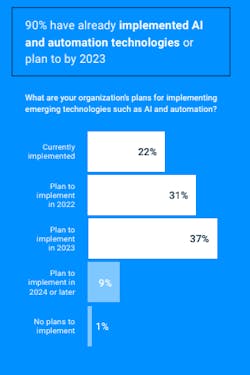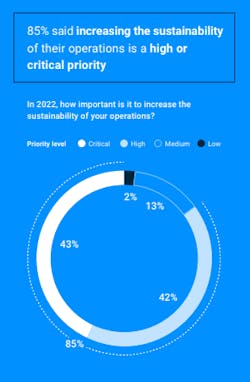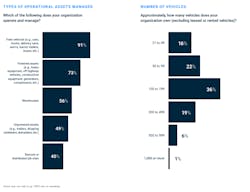SAN FRANCISCO—More fleets are looking to artificial intelligence to help guide their drivers, vehicles, business decisions, and employee satisfaction as the technology becomes more ingrained in the transportation industry.
Nine in 10 operations leaders have or plan to implement more AI and automation technologies by next year to increase safety and reduce repetitive worker tasks, according to a multinational survey of operations leaders released by Samsara during its Beyond 2022 user conference.
See also: Samsara details how its data is making fleets smarter
Making operations more environmentally sustainable also was a high or critical priority for 85% of the 1,525 executives Samsara surveyed for its 2022 State of Connected Operations Report, which also has global insights on how fleets are embracing—or eschewing—digitization and workforce demands.
Transportation and construction operations leaders were surveyed in eight countries: the U.S., Belgium, France, Germany, Luxembourg, Mexico, Netherlands, and the U.K. An independent research firm conducted the surveys over two weeks in April and May, according to Samsara, a global digital fleet solutions company based here in the Bay Area.
Automating transportation safety
While more fleets want to explore decarbonization, Ingo Wiegand, senior director of product management at Samsara, said customers' primary focus is on safety. He explained how AI and automation have moved from new trucking technology to assets ingrained in the industry.
“I think there’s been a lot of excitement about AI—both on the driver and the fleet owner side,” Wiegand told FleetOwner.
AI transportation technology, such as in-cab alerts and video captures, has saved drivers and exonerated carriers countless times since the last decade when many drivers were against adding cameras in and on their vehicles.
“If you look at the history of figuring out safety incidents and how to reduce accidents, it was always looking at lagging indicators. If you looked at an accident video, something clearly happened, but you can’t do anything about it,” Wiegand explained. “Then as technology advanced, we could see if someone stepped on the brakes, like a harsh-braking event.
See also: Adding new technology requires driver buy-in, communication
“That means something happened and this person had to suddenly respond and step on the brake,” he continued. “With AI, you basically get the ability to look at some of the driver behaviors as they’re evolving.”
He explained that by seeing how drivers operate before accidents happen, such as following too closely, distracted, speeding, running signals, and braking behavior. “You look to prevent those behaviors and hopefully capture it before it happens. I think that’s why a lot of folks are getting really excited about it.”
Future plans and uses for AI
Samsara’s report said 90% of respondents have implemented AI and automation technologies or plan to by 2023. These technologies can address a need for increased safety and enable employees to spend less time on repetitive tasks.
Nine in 10 executives also expect AI and automation to increase employee retention. However, 95% of those implementing these technologies have already seen it help with employee retention.
Other AI and automation benefits respondents are finding include more business agility (45%), better employee safety (44%), greater upskilling opportunities for employees (43%), and higher employee satisfaction (43%).
Compared to respondents in the beginning stage of digitization, Samsara said connected operations leaders were more likely (plus 31%) to report higher employee satisfaction as a benefit.
Wiegand said that fleets are moving from looking for data to wanting insights. “We have a lot of data—and a lot of customers don’t care about seeing that raw data of every event that happened,” he said. “But they care about knowing the five drivers they need to talk to. So if I have just 10 minutes, who should I coach?”
Wiegand said Samsara is developing not only more ways to collect data but to organize that data so “at every level of an organization, people can make effective decisions.”
Developing decarbonization decisions
A big decision approaching fleets of all sizes is over sustainability. Aided by soaring fuel prices, decarbonization is on the minds of fleet and other equipment operations, according to the Connected Operations Report.
More than half (65%) of respondents said their operations plan to increase sustainability investments this year. This focus will only sharpen as pressure mounts from regulators, investors, customers, and employees alike, according to Deepti Yenireddy, senior director of product at Samsara.
“Regulations in the E.U. and the U.K. are a little bit more aggressive than in the U.S.,” Yenireddy, who is based in London, told FleetOwner. “The regulations here are catching up to increase electrification, reduce carbon emissions, and so on.”
This year, Yenireddy and her team in the U.S. have been working with more than 40 Samsara customers, OEMs, EV charging infrastructure providers, and other stakeholders to see where the industry is and help its customers discover their best paths to decarbonization.
They found disparate approaches: “Some who haven't even thought about it but want to learn more. Some who have electrified a small percentage. Some who have completely electrified,” Yenireddy said. “Our mission is to help each of these customers, no matter where they are in their electrification journey through our connected platform.
Figuring out how to electrify a fleet
Samsara’s Connected Operations Cloud is used by customers with fleets of all duties. It now offers a Fleet Electrification Report that tracks potential electrification criteria—average and max miles driven, fuel costs, route types, and more—to help customers find light-duty vehicles in their fleets most qualified for EV replacement. Samsara also offers EV fleet data and insights to help those already operating zero-emission vehicles optimize charging and performance.
Small vehicle fleets, particularly people-moving operations, are more likely to use EVs, Yenireddy noted. But interest in decarbonization is shared by fleets of all sizes and duties.
See also: Fleets and their customers are driving decarbonization
“Passenger EVs are a lot more prevalent than light-duty, medium-duty, and then heavy-duty,” she said. “We are noticing that customers in car rentals, ride-sharing type of companies are more fully electrified. Next is field services or last-mile delivery in terms of light-duty and medium-duty vehicles. On the heavy-duty side, we're not seeing many commercially available models.”
With series production just beginning on some major OEM’s battery-electric Class 8 tractors, Yenireddy said the trucking industry is still testing and figuring out how to implement EVs into operations.
“But the interest is across the board,” she said. “With diesel prices hitting $5 and above—and even higher in the E.U. and U.K.—folks are feeling it a lot more as they track costs. They are trying to figure out what kind of fuel savings they can get by implementing tools such as ours, driving coaching programs, and electrification as well. The interest is across the board.”









